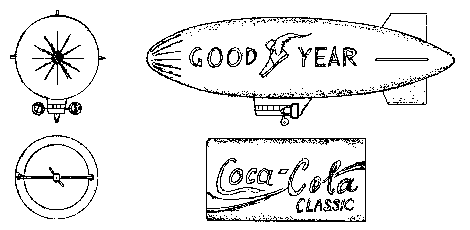We indicated we would tell you some new "ideas". These are cool inventions that I started and then got side tracked with other more immediate ideas, so in essence have abandoned them by publishing it all on here the web. (Actually one has a full year to file a patent in the USA after first public disclosure.) Prior to this we always had people sign proper Confidential Non-Disclosures before telling them what was on our mind and showing them any of Larry Wood's or Steve Crompton's terrific concept artwork along with our detailed business plans.

How about a giant Blimp for televising sports and flying along beaches that was identifiable as a product itself from the crowd below. Yes - a giant flying beer can, soda pop can, soup can, etc. The idea here was to have about the same billboard area as the famous good ol Good Year blimp, but have a much cheaper machine to operate. Our ship was to be a hollow tube in order to get the same bill board size with one tenth the helium (a much lighter "hollow" craft. Don't forget that when Good Year first started aerial TV broadcasting that the equipment was heavy! Fancy, super high resolution, gyro stabilized, broadcast camera systems no longer weigh anywhere near the 790 pounds of Good Year's Gyro Cams.

Size Comparisons
| Diameter | Overall length | Billboard Length | Helium Volume | |
| Good Year Blimp | 50 feet | 192 feet | 110 feet | 243,000 cu. ft. |
| Flying Can Blimp | 50 feet | 100 feet | 100 feet | 24,300 cu. ft. |
Unlike the Good Year blimp, we planned to save a lot of weight by not being able carry any passengers - just the pilot. You can see the pilot's cockpit pod and two counter-rotating, efficient large diameter propellers fore and aft of his cockpit - all mounted on streamlined struts. Of course, all on board TV cameras would be pointed and zoomed remotely from people inside a ground trailer - no need for additional on-board crew and their weight -it's simple to do nowadays! The Good Year Blimp requires a traveling 32 person crew and supposedly $2.2 million a year for that crew. We think we can do it all with a pilot and a four man ground crew. And best of all since we use about one tenth of the expensive helium, we can much more easily afford to deflate it, if evil weather jumps up on us. Deflating it without throwing a way a lot of expensive helium also, makes taking it to shows in Australia during America's cold winters a better economic deal for all!
How we planned to accomplish that labor saving and more important how do you build an inflatable structure with a nice flat cylindrical outside surface instead of a bunch of bulges is discussed on the next page.